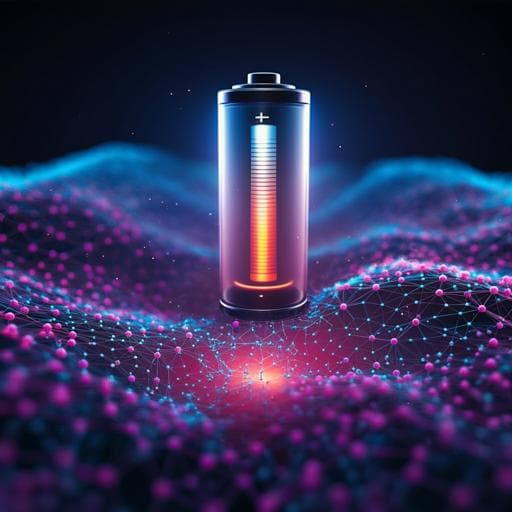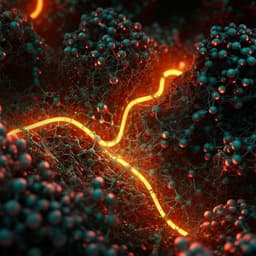
Engineering and Technology
Machine learning-guided discovery of ionic polymer electrolytes for lithium metal batteries
K. Li, J. Wang, et al.
Discover the innovative machine learning workflow that merges quantum calculations with graph convolutional neural networks to identify ionic liquids ideal for ionic polymer electrolytes in lithium metal batteries. This pioneering research, conducted by Kai Li, Jifeng Wang, Yuanyuan Song, and Ying Wang, results in IPE membranes boasting remarkable performance metrics.
~3 min • Beginner • English
Introduction
Ionic polymer electrolytes (IPEs) incorporating non-flammable ions within mechanically supporting polymers that provide predetermined ion-conduction pathways are attractive for safe, high-energy electrochemical devices. Ionic liquids (ILs) offer low vapor pressure, high thermal stability, wide electrochemical windows, and high ionic conductivity, making them promising electrolyte components. In lithium metal batteries (LMBs), electrolytes must suppress dendrites, minimize side reactions, and balance conductivity with mechanical modulus. Liquid-crystalline polymers have reduced interfacial resistance and introduced unique ion-conduction mechanisms. Rigid-rod polyelectrolytes, such as PBDT, can provide mechanical integrity and nanoscale structuring to enhance Li-ion transport in composites. However, selecting suitable ILs from a vast compositional space remains challenging. Machine learning (ML) can accelerate discovery by learning structure–property relationships, but data scarcity and overfitting limit accuracy of property predictions for new ILs. This work proposes a combined unsupervised and supervised ML workflow, integrated with quantum chemistry and GCNN models, to screen ILs that simultaneously meet high ionic conductivity and wide electrochemical window requirements for IPEs in LMBs, followed by experimental validation using PBDT-based membranes and LiFSI-containing ionic liquid electrolytes.
Literature Review
Prior research established that ILs possess desirable attributes for safe electrolytes (low volatility, thermal stability, wide electrochemical windows, high conductivity). Liquid-crystalline polymers can reduce interfacial resistance and improve ion transport in LMBs. Traditional ML efforts have predicted individual IL properties such as melting point, viscosity, and ionic conductivity using statistical models and descriptors; however, limited numbers of unique ILs and repeated measurements across temperatures can lead to overfitting and inflated accuracy. Estimating electrochemical windows (ECW) via theory is also challenging, with discrepancies influenced by model assumptions and ion association effects. The authors highlight ammonium-based cations and imide-based anions as generally promising for ECW, and note that imidazolium and ammonium cations often exhibit high conductivity, aligning with trends in prior datasets. This study addresses gaps by: (1) jointly considering conductivity and ECW as selection criteria; (2) focusing on commercially available ILs (IoLiTec) to enhance practical relevance; (3) using GCNN for classification with graph-to-property relationships; and (4) validating against the NIST ILThermo database and experiments.
Methodology
Machine learning workflow: The authors scraped 74 cations and 30 anions from IoLiTec, generating 2220 unique IL pairs. Only <13% had measured properties. Molecular descriptors were generated using RDKit (60 structural and 3D descriptors for cations, anions, and pairs) and Psi4 (14 electronic features including energies, HOMO/LUMO, and dipole moments for cations and anions). Unsupervised learning (boxplots, pair plots, hierarchical clustering via SciPy’s Dendrogram) explored distributions and correlations (e.g., conductivity vs viscosity; ECW trends by ion type) and clustered candidates using computed ECW and top XGBoost features.
Supervised learning: Ensemble classification (SVM, RF, XGBoost) and GCNN predicted room-temperature phase (solid/liquid). For liquid candidates, conductivity classification (σ ≥ 5 vs < 5 mS cm⁻¹) and regression at 25 °C were performed using SVM, RF, and XGB with 5-fold cross-validation and GridSearch for hyperparameters. GCNN was used for phase classification and not for conductivity tasks, to reduce complexity. ECW was estimated via HOMO/LUMO theory using Psi4: VCL = max(−ELUMO+/e, −ELUMO−/e), VAL = min(EHOMO+/e, EHOMO−/e), ECW = VAL − VCL. A conductivity threshold of 5 mS cm⁻¹ and ECW > 4 V were used for screening. Binding energies between cation–anion pairs were computed (Gaussian16) using B3LYP/6-311g** for geometry optimization and M062X/6-311+G(2d,p) with D3 dispersion for energies.
Experimental preparation of IPEs: A rigid-rod polyelectrolyte, PBDT (synthesized via interfacial condensation of BDSA and TPC), was combined with selected ILs to form precursor composite membranes via solvent evaporation (typically water as solvent; DMF for DemaTFSI). Membranes (5–10 wt% PBDT) were vacuum-dried and then ion-exchanged by immersion in a highly concentrated ionic liquid electrolyte (ILE): LiFSI dissolved in N-propyl-N-methylpyrrolidinium FSI (C3mpyrFSI) at 3.2 mol kg⁻¹ to load Li⁺. The resulting IPE membranes were ~50 µm thick, transparent, and mechanically robust.
Electrochemical and physical characterization: Cyclic voltammetry (Li|IPE|SUS) assessed Li plating/stripping and anodic stability; Li|Li symmetric cells were used for polarization, impedance, and cycling, including DC polarization (10 mV) and EIS (1 Hz–1 MHz) to determine Li⁺ transference number (Bruce–Vincent method). Ionic conductivity was measured by dielectric response (100 mHz–1 MHz) from −50 °C to 150 °C using equivalent-circuit fitting. Li|IPE|Cu cells assessed coulombic efficiency during plating/stripping. Full cells used Li metal anodes and LiFePO₄ cathodes (10.3 mg cm⁻²) to evaluate cycling at various rates and temperatures (RT, 50 °C, 80 °C). Mechanical properties were measured via stress–strain (Young’s modulus) and dynamic mechanical analysis (storage modulus from −50 °C to 300 °C). SEM examined morphology and membrane thickness.
Key Findings
- ML screening: From 2220 IL candidates, 49 ILs met the criteria σ ≥ 5 mS cm⁻¹ and ECW > 4 V at RT. Phase classification (solid/liquid) accuracies: SVM 0.81, RF 0.83, XGB 0.85, GCNN 0.83. Conductivity classification (σ ≥ 5 vs < 5 mS cm⁻¹) accuracies: SVM 0.80, RF 0.82, XGB 0.80. Conductivity regression at 25 °C validated against NIST ILThermo for 18 overlapping ILs achieved R² = 0.82 and MAE = 1.8 mS cm⁻¹.
- Selected ILs for validation: C2mimTFO, C2mimBF4, C2mimES, DemaTFO, DemsTFSI. After ion exchange with LiFSI|C3mpyrFSI, DemaTFO-based IPEs failed to incorporate Li; the other four IPEs performed well.
- Mechanical properties: IPEs (~10 wt% PBDT, e.g., with C2mimTfO) exhibited yield strength 6.21 MPa and Young’s modulus ~300 MPa; DMA showed storage modulus >200 MPa from −50 to 300 °C.
- Electrochemical window: IPEs displayed cathodic stability suitable for Li plating; anodic stability approached ~6 V, with C2mimTFO and DemsTFSI exhibiting the highest anodic stability among tested IPEs.
- Li⁺ transference number: tLi⁺ = 0.4–0.5 for IPEs (vs 0.18 for LiFSI|C3mpyrFSI ILE); C2mimTFO and DemsTFSI reached tLi⁺ ≈ 0.5.
- Ionic conductivity: High σ at RT (~1 mS cm⁻3 as reported) with temperature-activated behavior; nanoscale fibrillar/nanocrystalline conducting phases from PBDT–IL composites underpin fast Li transport.
- Li|Li symmetric cells: Critical current density up to 6 mA cm⁻² at 80 °C (for C2mimTFO, C2mimES, DemsTFSI). At RT, stable cycling for at least 800 h at 1 mA cm⁻² without short circuit.
- Li|Cu cells: High coulombic efficiency with average >98% at RT, indicating reversible Li deposition and dendrite suppression.
- Full cells (Li|IPE|LiFePO4, 10.3 mg cm⁻²): At RT, 0.5C cycling showed ~96% capacity retention over 350 cycles with CE typically 100.1–100.2%. At 50 °C and 2C, ~80% retention at 350 cycles with CE >99.9%. High-rate capability at 80 °C up to 5C maintained ~120 mAh g⁻¹ without shorting; at 3C delivered 146 mAh g⁻¹. Overall efficiency exceeded 99.92% in testing.
Discussion
The study demonstrates that combining unsupervised and supervised ML, enriched with quantum-derived electronic features and graph-based representations, can efficiently identify ILs that simultaneously meet high conductivity and wide ECW requirements—two largely uncorrelated yet critical properties for LMB electrolytes. The workflow mitigates data scarcity and potential overfitting by emphasizing classification thresholds for practical screening and validating with external databases and experiments. Experimentally, integrating selected ILs with the rigid-rod PBDT matrix, followed by ion exchange with LiFSI in C3mpyrFSI, yields thin, robust IPEs with high modulus. This mechanical robustness, coupled with elevated Li⁺ transference numbers and tailored ion association, suppresses dendrite formation and stabilizes Li plating/stripping. The IPEs exhibit broad electrochemical stability windows and enhanced cathodic stability compared with neat ILs, plausibly due to high Li concentration, FSI-derived SEI formation, and PBDT-induced structuring. Consequently, the electrolytes enable high critical currents in symmetric cells and long-lived, high-loading LFP full cells with excellent coulombic efficiencies across room to elevated temperatures and at high rates, surpassing many single-layer polymer electrolytes lacking flammable organics. The findings affirm that ML-guided IL selection, when combined with a suitable polymer architecture, can bridge the trade-off between ionic transport and mechanical integrity in solid polymer electrolytes for LMBs.
Conclusion
This work establishes a practical ML-guided screening strategy to discover ILs for ionic polymer electrolytes by jointly targeting ionic conductivity and electrochemical window. The approach integrates RDKit/Psi4 descriptors, hierarchical clustering, ensemble classifiers, and GCNNs to down-select 49 promising ILs from 2220 candidates. Experimental validation using PBDT-based IPEs confirms high modulus, elevated Li⁺ transference numbers, broad ECWs, high critical current densities (up to 6 mA cm⁻² at 80 °C), long symmetric-cell lifetimes, and excellent full-cell performance at high cathode loadings and rates with high efficiencies. The platform is generalizable, facilitating rapid electrolyte discovery aligned with commercially available ILs. Future work may focus on: refining ECW predictions with environment-aware models; deeper quantum mechanical analysis of anion–polymer interactions to guide ion-exchange efficiency and transport; extending screening thresholds for higher-voltage cathodes; and expanding datasets to further improve predictive performance and transferability.
Limitations
- Data scarcity: Limited unique ILs with measured properties can constrain model generalizability; only 18 overlapping ILs were available for external conductivity validation at 25 °C.
- ECW estimation: HOMO/LUMO-based ECW calculations show mean absolute errors <1.1 V versus scraped values and can be sensitive to vacuum-model assumptions and ion association; certain ions (e.g., imidazolium, BF4−) show larger discrepancies.
- Model scope: GCNN was not applied to conductivity prediction in this workflow to limit complexity; conductivity classification/regression relied on traditional models.
- Experimental variability: Measured ECW depends strongly on testing conditions, complicating direct comparison with calculations.
- Material-specific behavior: One selected IL (DemaTFO) failed to incorporate Li during ion exchange, indicating that ion association and binding energies can limit applicability and require case-by-case assessment.
Related Publications
Explore these studies to deepen your understanding of the subject.







